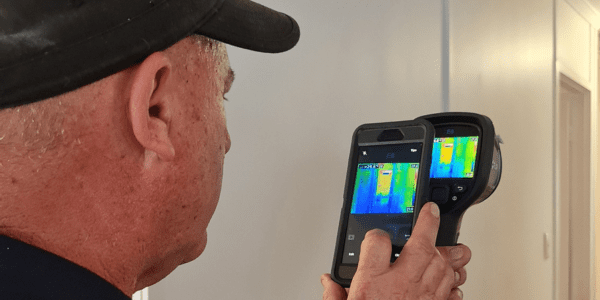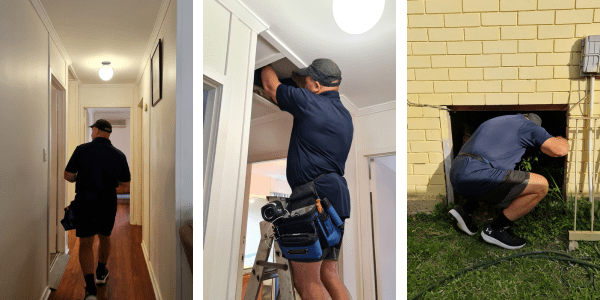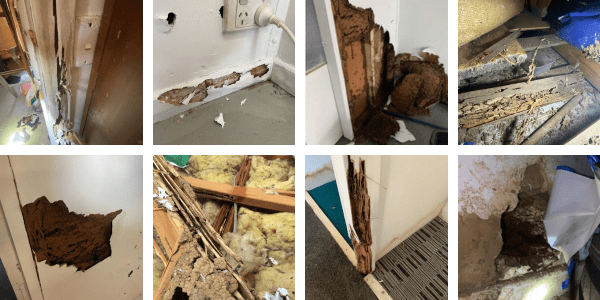Don’t miss your Annual Timber Pest Inspection!
Keep your home safe from termites
As a homeowner in Brisbane, protecting your property is a top priority. Among the many maintenance tasks you perform, one that often gets overlooked is an annual timber pest inspection. It is sometimes known as a termite and pest inspection. However, in a climate as conducive to pests as Queensland’s, this crucial inspection should be at the top of your list. Here’s why it’s essential and how you can benefit from keeping up with this vital home maintenance task.
The Threat of Timber Pests
Timber pests, including termites, borers, and wood decay fungi, pose significant threats to your home. These pests can silently and swiftly cause extensive damage to the structural integrity of your property. Termites alone are responsible for millions of dollars in damage annually across Australia. Unlike other pests, timber pests are often silent destroyers, causing substantial damage before being detected. Regular inspections are your best defense against these hidden threats.
Termites: The Silent Destroyers
Termites are arguably the most notorious of all timber pests. These insects live in colonies and can number in the hundreds of thousands. They feed on cellulose found in wood, making homes with timber structures particularly vulnerable. Subterranean termites, the most destructive species, build mud tubes to access above-ground food sources while remaining hidden. The damage they cause can be catastrophic if left unchecked.
Wood Borers: The Hidden Invaders
Wood borers, or wood-boring beetles, are another concern. These pests lay eggs in cracks and crevices of wood. When the larvae hatch, they burrow deep into the timber, creating extensive networks of tunnels. The presence of exit holes and frass (a fine, powdery residue) is often the first sign of an infestation. Like termites, wood borers can cause severe structural damage over time.
Wood Decay Fungi: The Silent Decomposers
Wood decay fungi thrive in damp, humid environments and can cause wood to weaken and rot. These fungi feed on the wood, breaking it down and reducing its structural integrity. Signs of wood decay include discoloration, softness, and a musty odor. While fungi may not be as immediately destructive as termites or borers, their presence can significantly compromise the safety of your home.
The Queensland Climate Factor
Queensland's warm, humid climate is ideal for timber pests. The combination of moisture and warmth creates the perfect breeding ground for termites, borers, and fungi. This makes Queensland homes particularly vulnerable to infestations. The importance of annual timber pest inspections cannot be overstated in such an environment. A timely inspection can identify early signs of infestation, allowing for prompt treatment and minimizing damage.
Given Queensland's conducive environment for timber pests, regular inspections are not just recommended—they are essential. In fact, Australian Standards and Queensland Building and Construction Commission advise that inspections be carried out at least every 12 months. By staying proactive and scheduling annual inspections, you can protect your home from these silent invaders and avoid the significant costs associated with pest damage.
What to Expect During an Termite and Pest Inspection
A professional timber pest inspection involves a thorough examination of both the interior and exterior of your home. Inspectors look for any evidence of timber pest activity, such as:
- Mud tubes: Indicative of subterranean termites, these tubes are often found on walls, foundations, and other structures.
- Wood damage: Hollow sounds when tapped, indicating that termites have eaten away the inside of the wood.
- Frass: Carpenter ant and termite droppings that resemble sawdust, often found near infested wood.
- Borer holes: Tiny exit holes left by wood borers, indicating an infestation.
- Fungi growth: Signs of wood decay, such as discolored or softened wood, often accompanied by a musty smell.
Using advanced tools like moisture meters and thermal imaging cameras, inspectors can detect potential issues that might not be visible to the naked eye. These tools help identify moisture levels, heat signatures of large active termite nests, and other indicators of timber pest activity.
The Inspection Process
The inspection process typically begins with a thorough visual examination of your property. Inspectors will check all accessible areas within 30 meters of the main building. This includes the interior, exterior, roof voids, crawl spaces and subfloors (if safe to do so). They will look for signs of timber pest activity and conditions conducive to infestations, such as moisture buildup and wood-to-soil contact.
In addition to the visual inspection, inspectors may use specialized tools to gather more detailed information. Moisture meters can detect elevated moisture levels, which are often a sign of termite activity or wood decay. Thermal imaging cameras can identify heat signatures that indicate the presence of a large, active termite nest.
Benefits of Regular Inspections
There are three main benefits of getting regular timber pest inspections, which include:
1. Early Detection and Prevention
Catching an infestation early can save you thousands in repair costs. Regular inspections ensure that any signs of timber pests are identified and addressed before they can cause significant damage.
2. Peace of Mind
Knowing your home is safe from timber pests allows you to rest easy. Regular inspections provide reassurance that your property is being monitored and protected.
3. Increased Property Value
Regular inspections can help maintain your home’s structural integrity, which is vital if you plan to sell. Potential buyers are more likely to invest in a property that has been well-maintained and is free from termite-related issues.
How Much Does an Annual Timber Pest Inspection Cost?
The cost of an annual timber pest inspection varies depending on the size of your home. As you can imagine, a large Queenslander home with large amounts of timber in the structure will take longer to inspect than a newly built brick home. At Dedant Building and Pest Inspections, our annual timber pest inspections start from $250 incl. GST (May 2024). We can also carry out a general pest control treatment for ants, spiders and other pests at the same time.
The Cost of Neglect
Neglecting regular timber pest inspections can have serious consequences. Without timely inspections, infestations can go undetected, leading to extensive damage and costly repairs. In severe cases, the structural integrity of your home can be compromised. Ultimately, making it unsafe to live in. The cost of repairing damage caused by timber pests far exceeds the cost of annual inspections, making this preventive measure a wise investment.
Book your Termite and Pest Inspection today!
Don’t wait until it’s too late. Schedule your annual timber pest inspection today and ensure your home is safe and sound.
At Dedant, all our inspectors are licensed and highly experienced at conducting timber pest inspections, termite treatments and installing chemical termite barriers. They are specially trained to identify evidence of termite activity and damage, giving you peace of mind that your Queensland home is free from termites.
We have been servicing Brisbane, Redland Bay, Moreton Bay, Gold Coast, the Scenic Rim, Sunshine Coast, Ipswich and Logan since 2009.
If you have any questions or would like to book, contact us on 07 3807 0122 or via our website.








